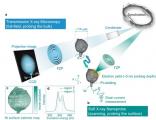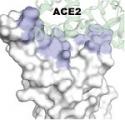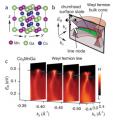Nitrogen is an essential component for life and often a limiting factor for growth, despite the fact that air is composed of mostly nitrogen. The processing required to turn dinitrogen (N2) gas into a form usable by most living organisms is rare in nature. Breaking the triple bond of N2 requires the enzyme nitrogenase, which is found in some bacteria. The mechanism of nitrogenase, which uses metal ion containing cofactors to catalyze this energetically difficult reaction, is complex and difficult to decipher. A team of researchers has applied a new method to peek at the mechanism of the reaction by looking at the enzyme bound to its metal ion cofactors in an intermediate state.
Approximately 1,700 scientists visit SSRL annually to conduct experiments in broad disciplines including life sciences, materials, environmental science, and accelerator physics. Science highlights featured here and in our monthly newsletter, Headlines, increase the visibility of user science as well as the important contribution of SSRL in facilitating basic and applied scientific research. Many of these scientific highlights have been included in reports to funding agencies and have been picked up by other media. Users are strongly encouraged to contact us when exciting results are about to be published. We can work with users and the SLAC Office of Communication to develop the story and to communicate user research findings to a much broader audience. Visit SSRL Publications for a list of the hundreds of SSRL-related scientific papers published annually. Contact us to add your most recent publications to this collection.
The enzyme 3-Hydroxyanthranilate-3,4-dioxygenase (HAO) is critical for the metabolism of the amino acid tryptophan and the synthesis of the important coenzyme nicotinamide adenine dinucleotide (NAD+). Although the role of this enzyme has been long known, its mechanism and regulation have remained a mystery, because it is difficult to study. HAO creates the unstable product 2-amino-3-carboxymuconic semialdehyde (ACMS) that can self-cyclize into quinolinic acid (QUIN). Because excess amounts of QUIN have been implicated in neurologic diseases, HAO is a potential drug target. A group of scientists have determined the mechanism of the HAO enzyme by applying crystallographic techniques.
Lithium ion battery technology has made possible our most-used personal electronics. Improvements in lithium ion battery energy storage, which can lead to advancements in technologies like electric vehicles, depend largely on improvements to the cathode materials. Researchers value Ni-rich NMC (LiNixMnyCozO2; x+y+z ≈ 1, x ≥ y+z) layered oxide materials for their ability to achieve high energy density, but the performance can be limited due to aberrant surface reactions. Characterization these surface reactions and their relationship to the material’s structure will aid in improving NMC materials, but it is a difficult task, requiring new methods. A team of scientists have integrated new experimental tools for studying how the bulk microstructure and the surface chemistry the NMC cathode material are related and affect performance.
In the 1950’s and 60’s a poisoning occurred in Minamata Japan. In addition to the people, the local cat population was affected with what was called “Dancing Cat Disease” and shortly thereafter neurological signs and symptoms became more prominent in people. The sickness became known as Minamata Disease. Eventually it was shown to be a form of organic mercury poisoning. During the episode, pregnant women who were minimally or not obviously affected delivered infants who had neurological disorders such as seizures, microcephaly, and cerebral palsy.
The local company that caused the pollution employed a physician who played a role in determining the cause. He found that cats fed chemical effluent from the factory quickly developed signs similar to those seen in people with Minamata Disease. He preserved samples of brain tissue from one of the cats, and remarkably, these samples still exist. An international team of researchers used sophisticated modern techniques to analyze these samples and determine the chemical form of mercury within the tissue.
The COVID-19 pandemic triggered by the SARS-CoV-2 coronavirus is causing health and economic havoc on a global scale requiring the development of an effective vaccine and therapeutics. Spike proteins found on the viral surface of SARS-CoV-2 attach to human cells to gain entry. Neutralizing antibodies which target these same spike proteins of the CoV-2 virus would effectively block viral entry.
A research team reviewed data on ~300 antibodies from convalescent patients that target SARS-CoV-2 and found that the gene IGHV3-53 was the most frequently used to produce these antibodies.
Amyloid, composed largely of mis-folded proteins that form insoluble fibrillar aggregates, is important to many human diseases including Alzheimer’s. Tooth decay also features amyloid-forming proteins, but in this case it is not mis-folded human amyloid proteins but bacterial proteins that are not mis-folded when they aggregate into functional amyloid polymers. The most common infectious disease in humans, tooth decay, involves the formation of microbial communities in biofilms on teeth.
Some proteins can form complex cage structures that can trap, hold, catalyze, and release small molecular and atomic cargo based on environmental signals. These protein cages are made of a collection of identical monomer proteins self-assembled into a symmetric conformation. Protein cages are found in nature, including in virus capsids, and have attracted much interest for engineering them to perform specific functions. In the past, designed protein cages have formed highly porous, “wiffle-ball”-like assemblies, but a team of scientists have used knowledge of inorganic chemistry, such as metal-coordination preferences, to design a tightly-packed protein cage that more closely mimics natural protein cages.
Because they are highly efficient, low maintenance, and light, lithium-ion batteries have grown in popularity. Their use has improved the functionality of many electronics, such as allowing our cell phones to be more portable and our electric cars to travel longer distances. However, some precious metal components of these batteries are in short supply, prompting researchers to develop “beyond lithium-ion” alternatives that use elements more abundant on Earth, yet have the qualities that make lithium-ion batteries so useful. Attention has turned to using common divalent metals, such as calcium, magnesium, and zinc, at the anode for a new type of battery.
While steady improvement of lithium-ion batteries has allowed electronic technologies to perform better, researchers are nearing a theoretical limit to lithium-ion battery capacity. One way to overcome this limit is to change the chemistry of materials to allow more electrons to exchange between anode and cathode per unit of material. Currently, LiCoO2 lithium-ion batteries transfer one electron per unit of cathode, but other lithium-based materials may allow for higher capacity. A team of researchers has investigated the Li-rich layered sulfide Li2FeS2 and a novel analog LiNaFeS2 as potential higher capacity alternatives since they can store 1.5 or more electrons per unit.
Physicists have been interested in crystalline materials where the quantum mechanical behavior of electrons is governed by topology, so-called topological quantum matter. Recently the community has been particularly excited about crystals which additionally exhibit magnetism, i.e. topological quantum magnets. What new topological behavior might such magnets exhibit? Can we find examples of such exotic quantum magnets in nature? And could magnetic topological phases of matter lead to insights about fundamental questions in science or pave the way to technological applications?













